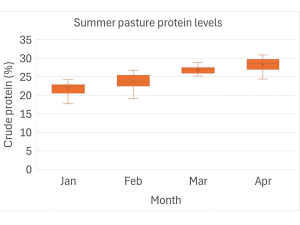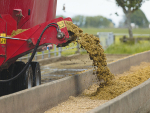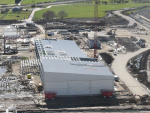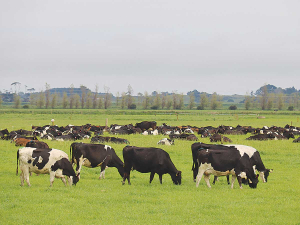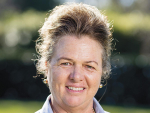As summer progresses, dairy farmers face two critical challenges: maintaining milk production and keeping weight on cows.
Dry spells often exacerbate these challenges, due to declining pasture supply and lower energy and crude protein (CP) content per kilogram of dry matter (DM). This can make it increasingly difficult to meet the nutritional needs of cows.
Maize silage is an excellent summer supplement for milking cows. Provided it is introduced slowly, it can be safely fed in large quantities, and on average, it has higher energy levels than pasture silage. However maize silage is a low protein feed and I touched on this issue.
In the December edition of Dairy News:
“Some farmers have raised the concern that maize silage, a low (8%) crude protein feed, is less suitable for coupling with lower-protein summer pasture.
“Monthly pasture analysis collected on Waikato farms since 2011 by Open Country Dairy has shown that pasture protein content consistently remains above 20%. This means farmers can feed up to one-third of the diet as maize silage in the summer while still providing a 14–16% CP diet. In most cases, this is sufficient dietary protein for cows in mid-lactation.”
Now, with pastures drying out and growth rates slowing, this is a timely opportunity to investigate summer protein supply further and explore how pasture and maize based diets can be influenced by small amounts of protein supplementation if required.
Understanding summer pasture protein levels
Twelve-year average data collected from 10 Waikato dairy farms between January and April shows an average pasture crude protein level of 24.8% (personal communication, Tim Sandbrook, Open Country Dairy). Figure 1 demonstrates this consistency over time, indicating that even in more challenging summer seasons, on average pasture protein levels are adequate to meet the requirements of an average NZ dairy cow.
Optimum protein requirements for dairy cows
Research by Dr Eric Kolver (2000)1 highlights that dairy cows in mid to late lactation require diets containing 14–16% crude protein to support milk production. This target is typically achievable when maize silage makes up no more than one-third of the diet, paired with quality pasture.
For example, feeding 30–40% maize silage as part of the summer diet ensures cows receive the energy needed to sustain production, even when pasture growth slows. In a herd producing approximately 1.3 kg MS/cow/day, this balance delivers adequate energy and protein under normal pasture conditions (Table 1).
| |
Feed Offered |
Utilisation % |
Drymatter Eaten (kgDM) |
Energy Content (MJME/kgDM) |
Total Energy Eaten (mjme) |
Dietary Crude Protein Content % |
| Pasture |
12 |
90 |
10.8 |
11.0 |
119 |
20 |
| Maize Silage |
6 |
90 |
5.4 |
10.8 |
58 |
8 |
| Total |
18 |
90 |
16.2 |
10.9 |
177 |
16 |
When pasture protein falls short
In some situations, pasture protein levels may dip below the long-term averages, or pasture supply makes up a smaller portion of the diet. In these cases, pairing maize silage with small quantities of high-protein feeds can make a significant difference.
For instance:
Exchanging just 1kg DM of maize silage with a protein-rich concentrate like sun-flower pellets (34% CP) or maize (golden) DDG (28%CP) can raise dietary protein content by around 1.0- 1.5%.
Exchanging just 1kg DM of maize with soybean meal, which contains around 48% crude protein, can boost total dietary crude protein by approximately 2%.
Although high-protein feeds can be more expensive, they are often needed only for short periods and in small quantities, making them a cost-effective solution when used strategically.
Proactive protein management
Maize silage is a cost effective and reliable feed source during summer, providing consistent energy to complement pasture. However, if pasture supply and/or protein levels drop, strategic supplementation with protein-rich feeds can help to maintain milk production.
Protein feeds are relatively expensive therefore I encourage farmers to use tools like DairyNZ’s Feed Checker Calculator (see FeedChecker calculator - DairyNZ | DairyNZ ) to assess whether summer diets meet minimum protein requirements. This tool allows farmers to experiment with small adjustments to the diet and measure their impact on overall nutrient balance and likely milk production.
If you need advice on your summer feeding strategy talk to your farm consultant or nutritionist or contact one of our Farm Systems Specialists, Matt Dalley or Wade Bell, at www.pioneer.co.nz.
Wade Bell is Genetic Technologies farm systems manager. Contact him at This email address is being protected from spambots. You need JavaScript enabled to view it.

